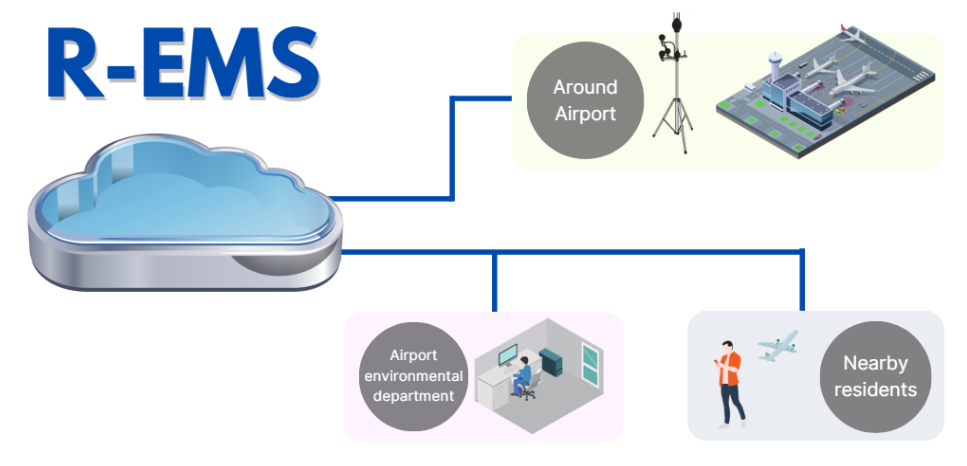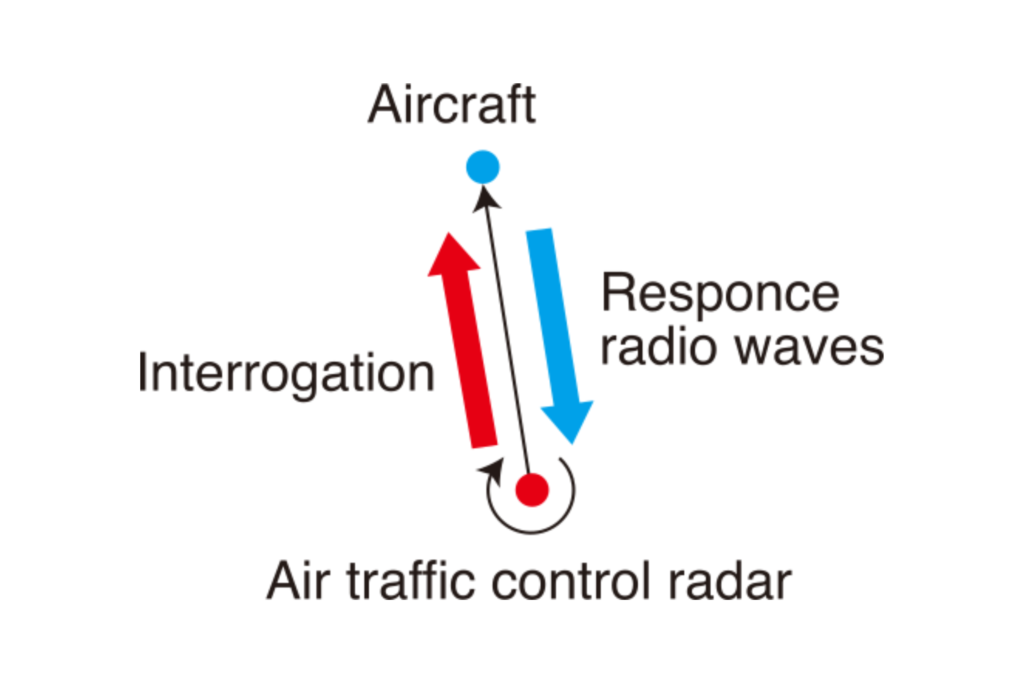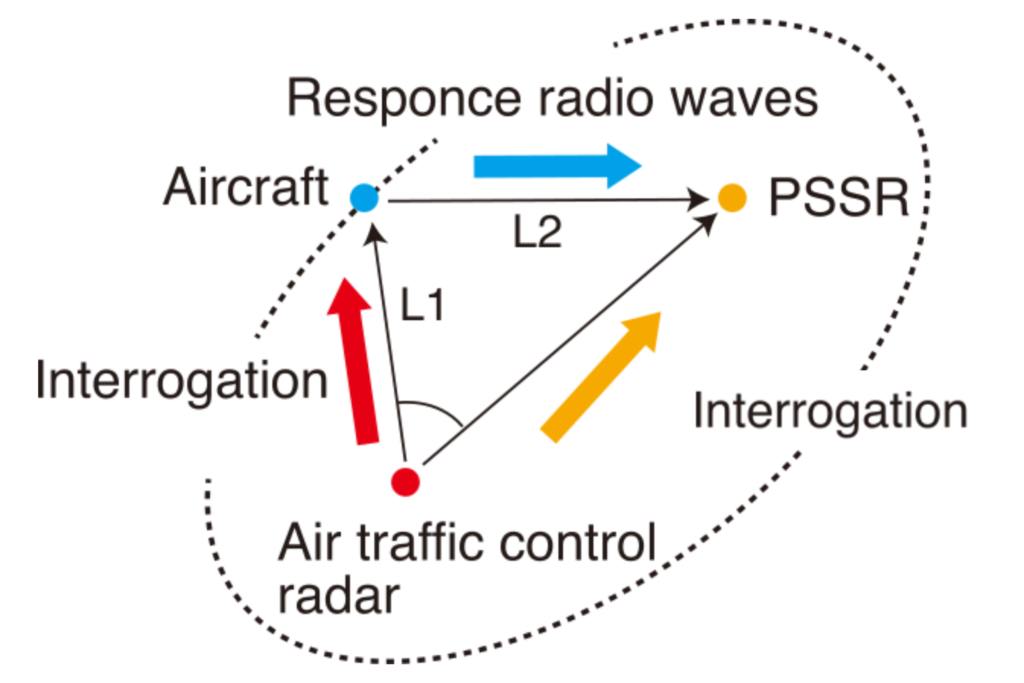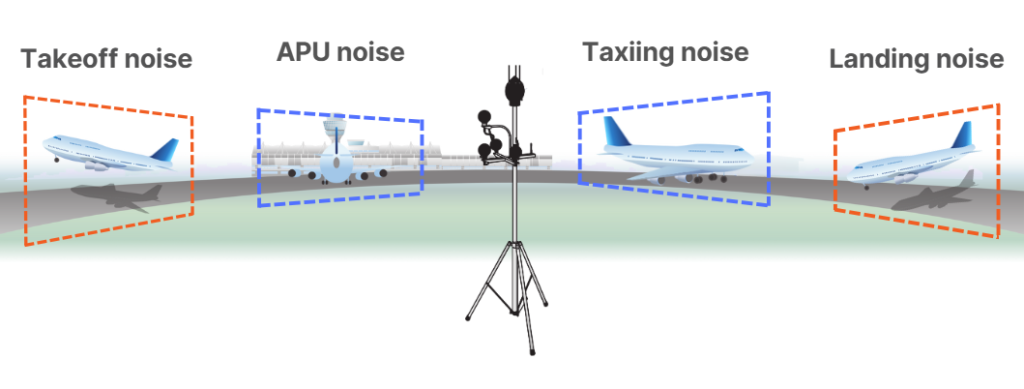
R-EMS is an innovative and comprehensive solution developed for managing aircraft noise, linking noise monitoring sites, offices and nearby residents.
R-EMS Configuration
Sound level meters are installed around the airport to measure aircraft noise and acquire flight track data.
The measured noise data is uploaded and integrated via the network into a cloud-based database along with flight track data, flight logs, and weather information. The system automatically identifies which flights in the database produced which noise, and correlates it with flight logs and weather conditions.
Operators can view and edit data using a web browser and can analyze and create reports.
R-EMS strongly supports the validation of noise maps according to the noise management plan of airport environment department.
It automates the validation and organization of noise events, minimizing the effort required to create noise reports.
Accumulated flight track data makes it possible to track and manage compliance with flight routes.
Visualizing the actual noise distribution and the actual flight track of aircraft on a map helps operators understand the causal relationship between aircraft behavior and the noise exposure situation at a given location. Analysis by arbitrarily setting conditions such as airline, aircraft, runway, and aggregation period will provide insight into isolating the complex factors that created the noise situation.
Residents can view noise information on a portal site and check the airport’s environmental measures. We provide a portal site as a communication platform for surrounding community. It provides a map that updates noise level and flight track in real time, and information on environmental measures implemented by the airport. It also functions as a two-way communication tool with residents that receives /responds to complaints. R-EMS helps to strengthen relationships of trust with the surrounding community.



Technical points of R-EMS
Tracking flight path
R-EMS can observe flight tracks on its own even when it is difficult for airports to provide radar data.
ADS-B (Automatic Dependent Surveillance-Broadcast)
By installing a receiver, it is possible to obtain position/altitude information from aircraft equipped with ADS-B and integrate it as flight track data. ADS-B is a system that allows aircraft to continuously broadcast their position and altitude. Unlike traditional transponder signals, which include only squawk codes and altitude data, ADS-B also transmits GPS-based position, unique aircraft identification, and other detailed information. By receiving and processing these signals, aircraft trajectories can be tracked.
PSSR (Passive Secondary Surveillance Radar)
PSSR is a unique technology of RION. PSSR acquires the positioning information of an aircraft by receiving interrogation radio waves from the ATC radar and response radio waves from the aircraft. By tracking the positions of aircraft without ADS-B, including military planes and helicopters, it becomes possible to manage aviation noise more effectively.






Acoustic identification technology






A unique 4-microphone structure analyzes the direction from which the sound is coming and identifies the source of the noise. Not only noise of aircraft in flight, but also ground noises such as APU, taxiing, and engine tests. This makes it possible to distinguish between ground noises outside the airport and ground noises generated at the airport, the impact of which has become a hot topic in recent years.



Sound source labeling using AI
We have developed a unique deep learning module and completed training specialized for aircraft noise. By combining this with the various flight tracking solutions and acoustic identification technology, we can achieve even more accurate identification.
Benefits of adopting R-EMS
In-house manufacturing ensures reliability
One of our major strengths is that we develop all our hardware and software in-house. RION sound level meters can withstand harsh environments. RION boasts the highest level of reliability in the market. Seamless integration of high-quality hardware and R-EMS software ensures stable system operation.
Flexible cloud-based operation
R-EMS is flexibility in system operation. Because R-EMS is a cloud-based system, it allows for flexible operation, including system operation agency, automatic daily health check, remote maintenance, and rapid customer support.
Adaptable to diverse regional needs
R-EMS is adaptability to diverse regional needs. It is flexible and customizable, allowing it to meet the different needs of each country and company, and provide data suited to the purpose in the most optimal form.
Builds trust with local communities
R-EMS is assisting to build trust with the local communities. The communication platform with surrounding residents allows airports to significantly reduce the costs associated with community engagement.
RION is an acoustics professional with 80 years of history
The amount of noise data obtained by R-EMS, including frequency changes, is outstanding, demonstrating the company’s strengths as a professional in the field of acoustics.
RION has been pursuing acoustic technology for 80 years, and has consistently developed both hardware such as sound level meters and software such as R-EMS in-house. In addition, it operates the Kobayashi Physical Research Institute, which contributes to the development of acoustic technology from basic research to practical application. This unique structure has enabled RION to maximize measurement accuracy and data reliability, building industry-leading technology.
RION’s sound level meters also boast the world’s top market share, and perform stably even in harsh temperature and humidity environments. They are robust and reliable, providing accurate data for long periods of time.



R-EMS is not just a noise analysis tool, but a solution equipped with advanced acoustic expertise, enabling high-precision measurement and analysis in any environment. It helps airports implement reliable noise management plans and strengthen trust with the surrounding community, contributing to the expansion of airport operations.
